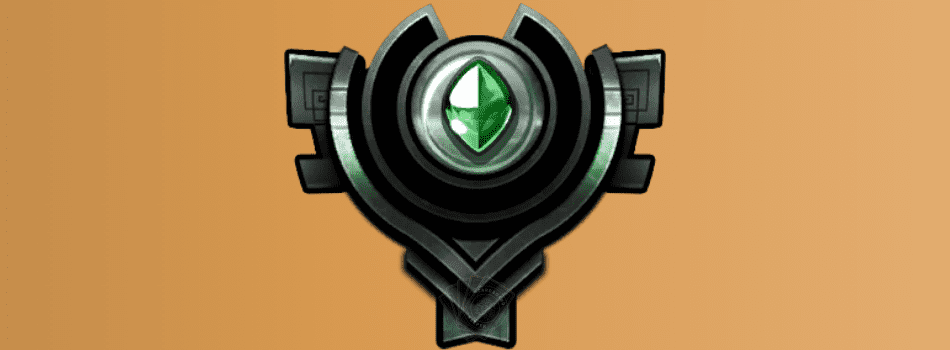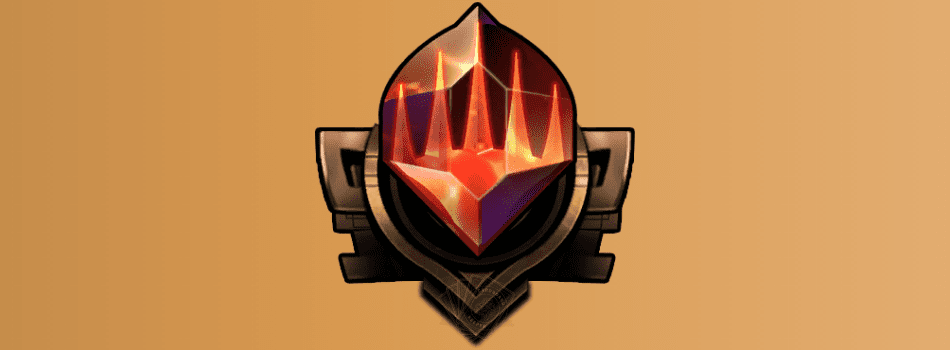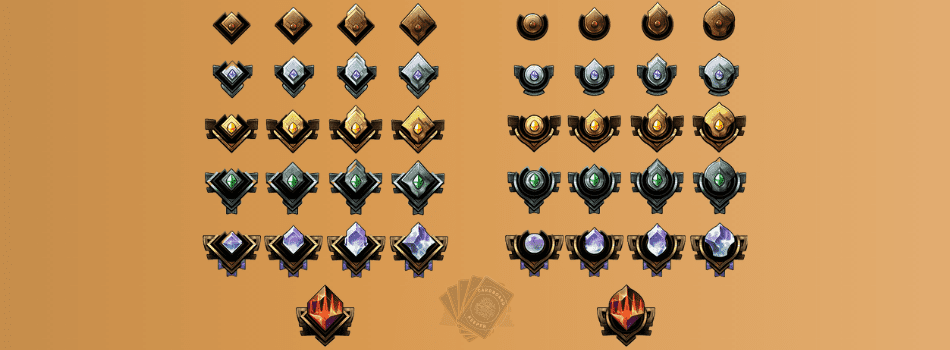After playing on Magic: The Gathering Arena (MTGA) for a few years now, understanding how the ranking system works has become second nature to me at this point. However, I sometimes get questions from new players who are a little confused as to what the different ranks within the game mean and how they can progress.
There are six ranks in Magic: The Gathering Arena: Bronze, Silver, Gold, Platinum, Diamond, and Mythic. In each non-Mythic rank, there are four sub-tiers before the next rank. To progress in ranking, players need to win a majority of their matches or win in events throughout the season.
Although many new players may not quite understand how the ranks work when they first start the game, it is not difficult to grasp and remember once you have been shown how it all fits together. I’ve dedicated this whole blog post to explaining how MTG Arena ranks work and answering some of the most frequent questions asked by new players. By the end of this post, you should be ready to start climbing the Magic Arena ranks like a pro!
What Are the Ranks in Magic The Gathering Arena?
As a general rule, ranks in Magic The Gathering Arena are designed to measure the skill level of players. The higher a player’s rank, the stronger that Magic player is. Separate ranks are awarded to Magic players based on their “Constructed” and “Limited” player skills.
There are two different ranks awarded to players as they play Magic The Gathering Arena, one for Constructed and one for Limited.
Constructed is the most common form of play where players create their own deck before games and play against one another. A player’s Constructed rank will be affected when a player chooses to play in Ranked Standard or Historic Constructed queues.
Playing unranked games of Magic will not affect a player’s rank. Playing unranked games is a great way for new players to gain experience without dropping some of their ranking points.
When playing a Limited format like “Draft” or “Sealed” constructing a deck is a part of the challenge.
To play a Limited game of Magic, one must pay a fee. For this reason, Limited matches are almost always considered as ranked matches by MTG Arena.
This means if you ever find yourself playing a Limited format on MTG Arena, you can expect your Limited rank, the rank that is only associated with your Limited performance, to be affected.
Currently, there is no way to play games of Limited Magic: the Gathering Arena without affecting your Limited ranking.
There are 6 different arena ranks in Magic: The Gathering along with 4 Tiers within each non-Mythic rank. These ranks in order are:
- Bronze
- Bronze Tier 1
- Bronze Tier 2
- Bronze Tier 3
- Bronze Tier 4
The same structure applies to the Silver, Gold, Platinum, and Diamond ranks. However, the Mythic rank does not follow this structure.
Each player is assigned the rank of Bronze when they first start playing MTG Arena.
Rankings are determined based on skill, moving advanced players up in both their tier and eventually rank. In Constructed games, the different tiers have 6 steps. However, for Limited, each tier has five steps, except for Bronze, which has four.
Below is a list for each of the rankings. The rewards for each of the ranks are based on the current session.

Bronze
The reward for the Bronze ranking is one booster pack.

Silver
The reward for the Silver ranking is one booster pack, along with 500 gold.
There are two different types of currency in Magic: The Gathering. One being gold, and the other being gems. This means that an additional 500 gold can be extremely beneficial, especially for a less advanced players looking to build out their digital card collections. In MTG, gold is worth between 87 and 99 cents per 1,000 gold.
Players use gold to purchase items from the Arena store, such as cosmetic items and packs. MTG players can also use gold to enter into specialty events.

Gold
The reward for the Gold ranking is two booster packs, along with 1,000 gold and a card art style.

Platinum
The reward for the Platinum ranking at the end of the session is 3 booster packs, along with 1,000 gold, and 2 cosmetic card styles.

Diamond
The reward for the Diamond ranking is four booster packs, along with 1,000 gold and 2 cosmetic card styles.
The only difference between the rewards for Platinum and Diamond is the one additional booster pack with Diamond.

Mythic
The reward for the Mythic ranking is five booster packs, along with 1,000 gold, 2 cosmetic card styles.
The only difference between the Diamond and Mythic rewards is the additional booster pack in Mythic, if you don’t count the bragging rights of ending the session at such a rank!

How Do MTG Ranks Work?
The way Magic: The Gathering ranks work is quite simple, making it practical and convenient for players. Below is a helpful chart that will help you to discover how the different ranks work, and which rank/tier precedes the next.
For each rank, with the exception of Mythic, there are four tiers. Each player starts off at the fourth tier and then advances until they are at tier one. Players will match off against other players in the same or similar ranking.
This gives them the opportunity to demonstrate their abilities against others who are of the same skill level. If inexperienced players were matched up with a highly advanced player all the time, it wouldn’t create a great gaming experience for anyone!
The different ranks allow for a fair fight between the players and the opportunity to slowly improve over time while playing the game.
In addition to winning the regular matches, there are opportunities to earn ranks through a variety of events. During the season, events become available which can be entered by paying with gold or gems. There are times, however, when the events require gems to enter, which means that you will want to start saving up.
What Is a Good Rank in MTG Arena?
Any ranking in Magic: The Gathering is something to be proud of. Each of the tiers in Bronze and Silver are considered to be average. Reaching the beginning tier of Silver should not be an extremely difficult task for players playing the game consistently.
It only takes winning about 1/3 of your matches to advance to the Silver ranking. In general, often players don’t consider themselves as “advanced players” until they reach the Platinum ranking.
The Gold tier is for players who are somewhere in the middle. It is for those who spend large amounts of time playing the game but do not quite have the skill level of the more experienced players yet.
Some consider Gold to be for advanced players, while others believe this status is not achieved until reaching the Platinum ranking.
No matter if you think that Gold is advanced or not, there is no question that Platinum rank players aren’t pushovers and have a knack for what the game entails. You can assume that any player from Platinum-Mythic is skilled at the game and is serious about the game or has been playing for a while.
Can You Rank Down in MTG Arena?
Ranking down is not possible in a Magic: The Gathering Arena. Even with multiple and frequent losses, you will not lose your ranking.
This is wonderful news for those in the upper rankings, as they do not have to worry about all of their hard work being downgraded. However, it is possible to go down in tier. For instance, if you are in Gold 3, you can move down to Gold 4 if you experience too many losses.
Much to their dismay, it is extremely common for those who are in the Platinum and Diamond rankings to move down in tier due to the average skill level of players increasing at those ranks.
However, at the end of each session is the one time players will find their ranks actually dropping.
At the end of each session, a player’s ranks will reduce by a certain amount giving players the opportunity to climb the ladder for a new session and win prizes.
You can check out the table below to see how a player’s rank will change at the end of each session.
| Previous Rank | New Rank |
|---|---|
| Bronze Tier 4 | Bronze Tier 4 |
| Bronze Tier 3 | Bronze Tier 4 |
| Bronze Tier 2 | Bronze Tier 4 |
| Bronze Tier 1 | Bronze Tier 3 |
| Silver Tier 4 | Bronze Tier 3 |
| Silver Tier 3 | Bronze Tier 3 |
| Silver Tier 2 | Bronze Tier 2 |
| Silver Tier 1 | Bronze Tier 2 |
| Gold Tier 4 | Bronze Tier 1 |
| Gold Tier 3 | Silver Tier 4 |
| Gold Tier 2 | Silver Tier 3 |
| Gold Tier 1 | Silver Tier 2 |
| Platinum Tier 4 | Silver Tier 1 |
| Platinum Tier 3 | Gold Tier 4 |
| Platinum Tier 2 | Gold Tier 4 |
| Platinum Tier 1 | Gold Tier 3 |
| Diamond Tier 4 | Gold Tier 3 |
| Diamond Tier 3 | Gold Tier 2 |
| Diamond Tier 2 | Gold Tier 2 |
| Diamond Tier 1 | Gold Tier 1 |
| Mythic | Platinum 4 |
How to Rank Up In MTG Arena
Increasing your MTG Arena ranking normally requires six points.
This is often the same for both the Limited and Constructed formats. For those who are in Bronze, Silver, or Gold, winning a match gives the player two points, and losing one takes away one point.
For those in Platinum and Diamond, winning a match gives you one point, and losing a match takes away one point. Because of this, advancing in Platinum requires more skill and winning a majority of the matches.
Once players reach this ranking, they must play more competitively because of the way that points are distributed.
Those who are in the Mythic rank no longer have tiers. Instead, a percentile is given, which compares players in the Mythic ranking. This allows players to track their progress and see how they compare to the others who play Magic: The Gathering Arena.
If players are able to advance high enough to reach the top 1,200, then the percentage turns into a number, ranking all of those in the top 1,200.
How Many Players Are Mythic In MTG Arena?
Very few players achieve the Mythic ranking in Magic: The Gathering Arena.
The Mythic ranking is the highest of the six ranks and requires a decent amount of skill and time put into the game to achieve it. However, advanced players prove that it is not impossible as they eventually make it to this rank almost every session.
During my time playing ranked games of Magic The Gathering Arena and reaching the mythic top 1,200, it’s not uncommon to face off against familiar usernames each session in the top bracket of players.
Less than 10% of Magic: The Gathering players receive Mythic ranking. Although this is an impressive achievement, and of course an accomplishment to relish in, there is still more to work for in the game. Mythic players have the opportunity to become one of the top 1,200 players. Once a player is in the top 1,200, a number will appear telling them which place they are in.
After a player reaches the top 1,200 they will constantly need to fight to maintain their ranking. These advanced players’ rankings are always in jeopardy as other players work to surpass them.
With all that being said, try not to get to fixated on what rank you have in Magic The Gathering Arena. As someone who has less and less free time to play the game I often find myself falling short of Mythic rank in recent sessions due to not having enough time to play the game.
As cliche it may sound, play the game to have fun – at the end of the day, the ranks don’t actually matter as much as the fun you are having!

